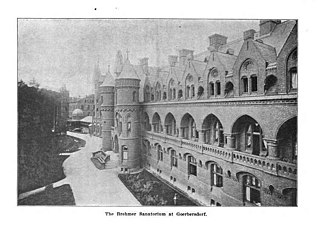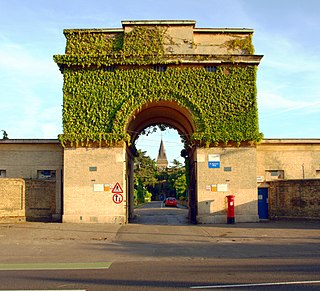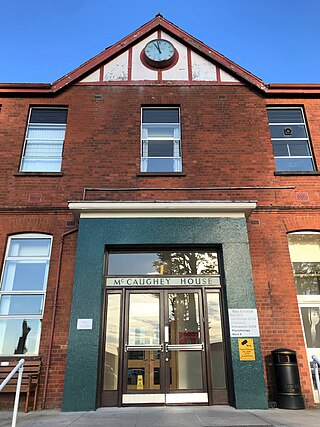
A sanatorium, also sanitarium or sanitorium, are antiquated names for specialised hospitals, for the treatment of specific diseases, related ailments and convalescence. Sanatoriums are often in a healthy climate, usually in the countryside. The idea of healing was an important reason for the historical wave of establishments of sanatoriums, especially at the end of the 19th- and early 20th centuries. One sought, for instance, the healing of consumptives, especially tuberculosis or alcoholism, but also of more obscure addictions and longings of hysteria, masturbation, fatigue and emotional exhaustion. Facility operators were often charitable associations such as the Order of St. John and the newly founded social welfare insurance companies.

The Waverly Hills Sanatorium is a former sanatorium located in the Waverly Hills neighborhood of Louisville, Kentucky.

University Hospital Hairmyres is a district general hospital in the Hairmyres neighbourhood of East Kilbride, South Lanarkshire, Scotland. The hospital serves one of the largest elderly populations in Scotland. It is managed by NHS Lanarkshire.

St Bernard's Hospital, also known as Hanwell Insane Asylum and the Hanwell Pauper and Lunatic Asylum, was an asylum built for the pauper insane, opening as the First Middlesex County Asylum in 1831. Some of the original buildings are now part of the headquarters for the West London Mental Health NHS Trust (WLMHT).

Holloway Sanatorium was an institution for the treatment of those suffering temporary mental illness, situated on 22 acres (9 ha) of aesthetically landscaped grounds near Virginia Water in Surrey, England, about 22 miles (35 km) south-west of Charing Cross. Its largest buildings, including one listed at Grade I, have been restored and supplemented as Virginia Park, a gated residential community featuring a spa complex, gymnasium, multi-purpose sports hall and an all-weather tennis court.

The Adirondack Cottage Sanitarium was a tuberculosis sanatorium established in Saranac Lake, New York in 1885 by Dr. Edward Livingston Trudeau. After Trudeau's death in 1915, the institution's name was changed to the Trudeau Sanatorium, following changes in conventional usage. It was listed under the latter name on the National Register of Historic Places in 1995.

The Seaside is a historic medical facility at 36 Shore Road in Waterford, Connecticut. It is nationally significant as the first institution designed for heliotropic treatment of children suffering from tuberculosis. Its buildings "comprise an exceptional collection of fully realized and generally well-preserved Tudor Revival-style institutional architecture", which were designed by Cass Gilbert. The property was listed on the National Register of Historic Places in 1995.
Lawrence Flick State Hospital was a state mental health hospital near Cresson, Pennsylvania that had several different names and uses before becoming defunct and converted into a prison in the 1980s.

Hawkmoor Hospital, originally known as Hawkmoor County Sanatorium, was a specialist hospital near Bovey Tracey in Devon, England, founded in 1913 as a pulmonary tuberculosis sanatorium as part of a network of such facilities, instigated by the Public Health 1912. From 1948, the hospital catered for patients with a range of chest ailments, as well as chest surgery, and mental disability patients. From 1973, the facility dealt solely with mental health problems until its closure in 1987.
The Rutland Heights State Hospital was a state sanatorium for the treatment of pulmonary tuberculosis located in Rutland, Massachusetts, USA built for the purpose of treating Tuberculosis patients. The facility was the first state-operated sanatorium in the United States, opening in 1898 and operating for around 93 years before its closure in 1991. Rutland Heights opened under the title “Massachusetts Hospital for Consumptives and Tubercular Patients,” to which it operated until 1900, where it was renamed to “Massachusetts State Sanatorium.” In 1919 it was renamed to “Rutland State Sanatorium,” which was the longest operating name of the hospital, effective until 1963. In 1963, it was renamed briefly to “Rutland Hospital,” and successively in 1965 to “Rutland Heights State Hospital,” which was the final title of the hospital until closing. In 2004, the hospital was demolished.
Pine Bluff State Hospital was a tuberculosis sanatorium and isolation hospital in Salisbury, Maryland, in the United States. The hospital was built by The Pine Bluff Sanatorium Company. The hospital grounds contain three parcels, the first is 0.46 acres (0.19 ha), the second is 1.534 acres (0.621 ha), and the third 8.35 acres (3.38 ha).

Pinewood is a rural area of Wokingham Without, near Crowthorne, in the English county of Berkshire, covered by the campus of the Johnson & Johnson Institute, the Pinewood Centre community club and society complex and a small industrial estate.
The town of Colorado Springs, Colorado, played an important role in the history of tuberculosis in the era before antituberculosis drugs and vaccines. Tuberculosis management before this era was difficult and often of limited effect. In the 19th century, a movement for tuberculosis treatment in hospital-like facilities called sanatoriums became prominent, especially in Europe and North America. Thus people sought tuberculosis treatment in Colorado Springs because of its dry climate and fresh mountain air. Some people stayed in boarding houses, while others sought the hospital-like facilities of sanatoriums. In the 1880s and 1890s, it is estimated that one-third of the people living in Colorado Springs had tuberculosis. The number of sanatoriums and hospitals increased into the twentieth century. During World War II, medicines were developed that successfully treated tuberculosis and by the late 1940s specialized tuberculosis treatment facilities were no longer needed.

The Firland Sanatorium was Seattle's municipal tuberculosis treatment center. It opened on May 2, 1911, and closed on October 30, 1973.

Sully Hospital was a psychiatric hospital in Sully, Vale of Glamorgan, Wales. It has since been converted into luxury apartments and remains a Grade II* listed building.

Norah Henriette Schuster FRCPath was a British pathologist and the first woman to take the pre-clinical medical course at the University of Cambridge. She was the first woman to be appointed as a doctor at the Manchester Royal Infirmary and, in 1950, the first female president of the Association of Clinical Pathologists.

Forster Green Hospital was a non-acute hospital located in Belfast, Northern Ireland. It offered a range of services including neurology, care of older people, and a child and family centre. The hospital was located on a 47-acre site in South Belfast. It was managed by the Belfast Health and Social Care Trust and closed in 2012. Located within the hospital grounds is the regional child and adolescent mental health inpatients unit, Beechcroft. This opened in 2010. Knockbreda Wellbeing and Treatment centre is also located within the grounds of Forster Green and opened in 2009. This has been described as a "one stop approach" to healthcare as it offers a wide range of healthcare services for the local community including general practice and physiotherapy.

Whiteabbey Hospital is a hospital located close to the village of Whiteabbey, within the town of Newtownabbey, Northern Ireland. The hospital first opened in 1907 as The Abbey Sanitorium, centred around a country house known as 'The Abbey'. The house has stood on the site from 1850, and was once the residence of prominent architect Charles Lanyon. The hospital was extended and several buildings added throughout the early 20th century, and it was renamed Whiteabbey Hospital in 1947. The hospital is managed by the Northern Health and Social Care Trust. Many healthcare services have been withdrawn from the hospital, most recently with the closure of the Minor Injuries Unit in 2014.

Eleanor Soltau (1877–1962) was an English doctor who led the first unit of the Scottish Women's Hospitals for Foreign Service in Serbia.

A tuberculosis hut or TB hut is a small wooden building that was used, mostly in the early twentieth century, by tuberculosis patients to recover in solitude.























